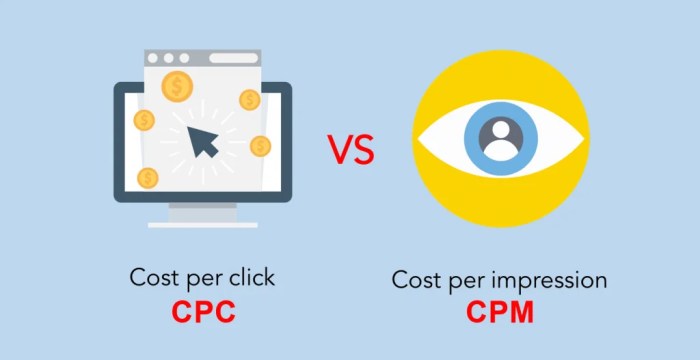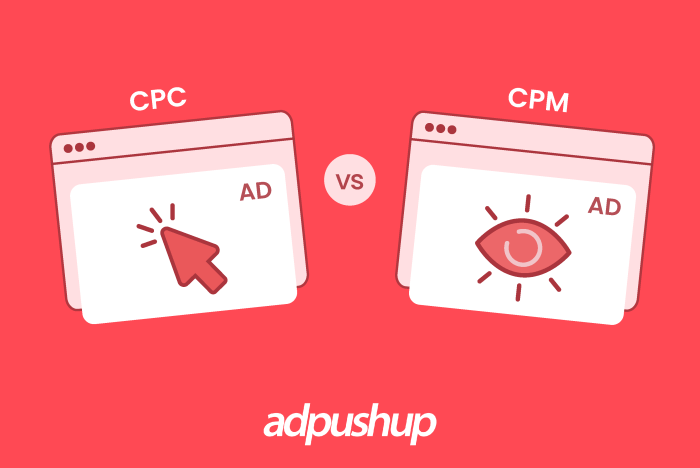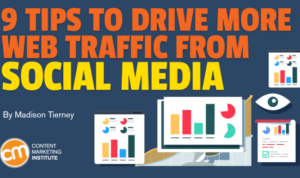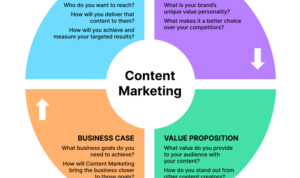Understanding CPC and CPM kicks off our journey into the world of online advertising metrics, where every click and impression counts towards success. Dive into the realm of ad performance measurement with us!
In this exploration, we uncover the key differences between CPC and CPM, how they impact various industries, and strategies to optimize these metrics for maximum results.
Introduction to CPC and CPM

In the world of online advertising, CPC and CPM are two common metrics used by advertisers to measure the performance of their ads.
Cost Per Click (CPC) is a pricing model where advertisers pay a fee each time a user clicks on their ad. This model is often used in search engine advertising, social media marketing, and display advertising.
Cost Per Mille (CPM), on the other hand, is a pricing model where advertisers pay a fee for every 1,000 impressions of their ad. This model is commonly used in display advertising and video advertising.
Differences Between CPC and CPM Pricing Models
- CPC: With CPC, advertisers only pay when a user interacts with their ad by clicking on it. This means that advertisers are only charged when there is direct engagement with the ad.
- CPM: CPM charges advertisers based on the number of impressions their ad receives, regardless of whether users interact with the ad or not. This can be beneficial for brand awareness campaigns.
Examples of Industries where CPC or CPM may be More Effective
- CPC: Industries where the focus is on direct conversions, such as e-commerce, lead generation, and affiliate marketing, may find CPC more effective as it ensures payment only when a user takes action.
- CPM: Industries that prioritize brand visibility and awareness, like luxury goods, automotive, and travel, may benefit more from CPM as it allows for broader reach and exposure to the target audience.
Factors Affecting CPC and CPM
When it comes to understanding CPC and CPM rates, there are several key factors that play a significant role in determining how much advertisers pay for their ads and how much publishers earn. Let’s delve into the main factors that influence these rates.
Ad Relevance, Competition, and Quality Score:
One of the most important factors affecting CPC is the relevance of the ad to the target audience. Ads that are highly relevant to users are more likely to receive clicks, resulting in a higher CPC. Additionally, the level of competition in the advertising space can impact CPC rates, with more competition leading to higher costs per click. Quality score, which is a metric used by ad platforms to evaluate the quality and relevance of ads, also plays a crucial role in determining CPC.
Ad Placement, Audience Targeting, and Ad Format:
When it comes to CPM rates, factors like ad placement, audience targeting, and ad format can significantly impact how much advertisers pay per thousand impressions. Ads placed in prime positions on a webpage or targeting specific audiences are likely to command higher CPM rates. Moreover, the format of the ad, such as display ads or video ads, can also influence CPM rates.
Seasonality and Market Trends:
Seasonal fluctuations and market trends can have a substantial impact on both CPC and CPM rates. During peak seasons or when there is high demand for advertising space, prices can increase significantly. Conversely, during slower periods, rates may decrease due to lower competition.
Strategies for Optimization:
To optimize CPC and CPM rates, advertisers can focus on improving ad relevance, targeting specific audiences effectively, and experimenting with different ad formats. Monitoring market trends and adjusting bidding strategies accordingly can also help advertisers maximize their ROI and achieve better results.
Calculating CPC and CPM: Understanding CPC And CPM
In digital advertising, it is crucial to understand how to calculate CPC (Cost Per Click) and CPM (Cost Per Thousand Impressions) to optimize ad campaigns effectively.
CPC Calculation
To calculate CPC, you can use the following formula:
CPC = Cost of Ad Campaign / Number of Clicks
- Step 1: Determine the total cost of the ad campaign.
- Step 2: Count the total number of clicks generated by the ad.
- Step 3: Divide the total cost by the number of clicks to get the CPC.
CPM Calculation Example
Calculating CPM involves dividing the total cost of the ad campaign by the total number of impressions, then multiplying by 1000.
For example, let’s say an ad campaign cost $500 and received 100,000 impressions. The CPM would be calculated as follows:
CPM = (Total Cost / Total Impressions) * 1000
CPM = ($500 / 100,000) * 1000
CPM = $5 * 1000
CPM = $5,000
Importance of Tracking and Analyzing Metrics
Tracking and analyzing CPC and CPM metrics is essential for campaign success as it helps advertisers understand the effectiveness of their ads. By monitoring these metrics, advertisers can optimize their campaigns, allocate budgets efficiently, and improve ROI.
Benefits and Challenges of CPC and CPM

In the world of online advertising, both CPC and CPM play crucial roles in helping advertisers reach their target audience effectively. Let’s delve into the benefits and challenges of using these two popular advertising models.
Benefits of CPC:
- Advertisers only pay when users click on their ads, ensuring that they are getting direct engagement from potential customers.
- CPC allows for better tracking of ROI since advertisers can measure the effectiveness of their campaigns based on the number of clicks received.
- It can be more cost-effective for businesses with a limited budget, as they are only charged for actual clicks.
Challenges of CPC:
- One major challenge with CPC is click fraud, where malicious entities click on ads to drain the advertiser’s budget without any intention of engaging with the content.
- Competition for popular s can drive up CPC prices, making it harder for smaller businesses to compete in the advertising space.
- Ad fatigue can also be an issue with CPC, as users may become less likely to click on an ad if they see it too frequently.
Benefits of CPM:, Understanding CPC and CPM
- CPM offers broader brand visibility, as advertisers pay for ad impressions rather than clicks, allowing them to reach a larger audience.
- It can be beneficial for brand awareness campaigns, where the goal is to increase visibility and reach rather than direct conversions.
- CPM can be a more cost-effective option for businesses looking to increase brand awareness on a larger scale.
Challenges of CPM:
- One challenge with CPM is ad viewability, as advertisers may not always know if their ads are being seen by users or if they are being displayed in a prime location on a webpage.
- CPM campaigns may not always lead to direct conversions, making it harder to measure the success of a campaign solely based on impressions.
- CPM rates can fluctuate based on demand and competition, potentially impacting the overall cost of running a campaign.
Successful Campaign Examples:
- Company A saw a 20% increase in website traffic after running a CPC campaign targeting specific s related to their product.
- Company B achieved a 15% increase in brand awareness by running a CPM campaign across popular websites in their industry.
Maximizing Benefits and Overcoming Challenges:
- For CPC, advertisers can combat click fraud by monitoring click patterns and using fraud detection tools to identify suspicious activity.
- Utilizing ad scheduling and frequency capping can help prevent ad fatigue and ensure that ads are displayed to the right audience at the right time.
- With CPM, focusing on ad viewability metrics and working with reputable publishers can help ensure that ads are being seen by the target audience.
- Testing different creatives and targeting options can help optimize CPM campaigns for better performance and ROI.





